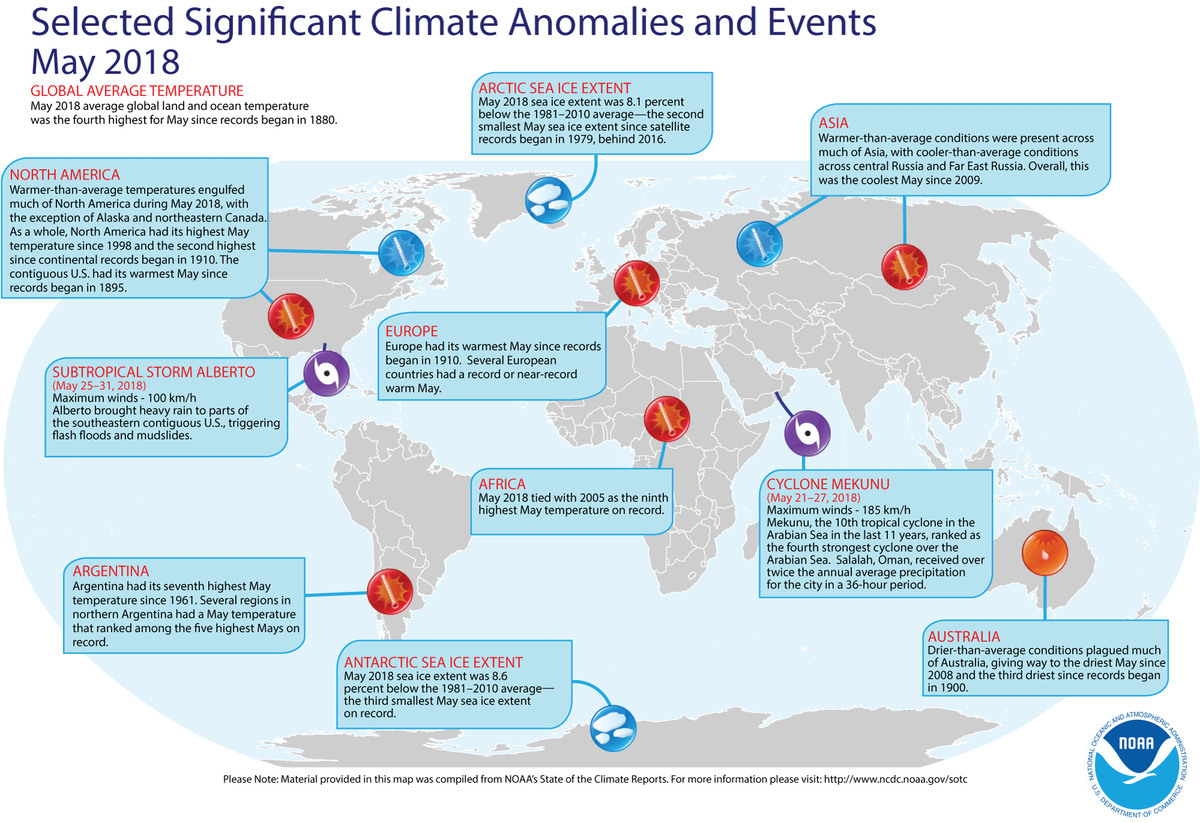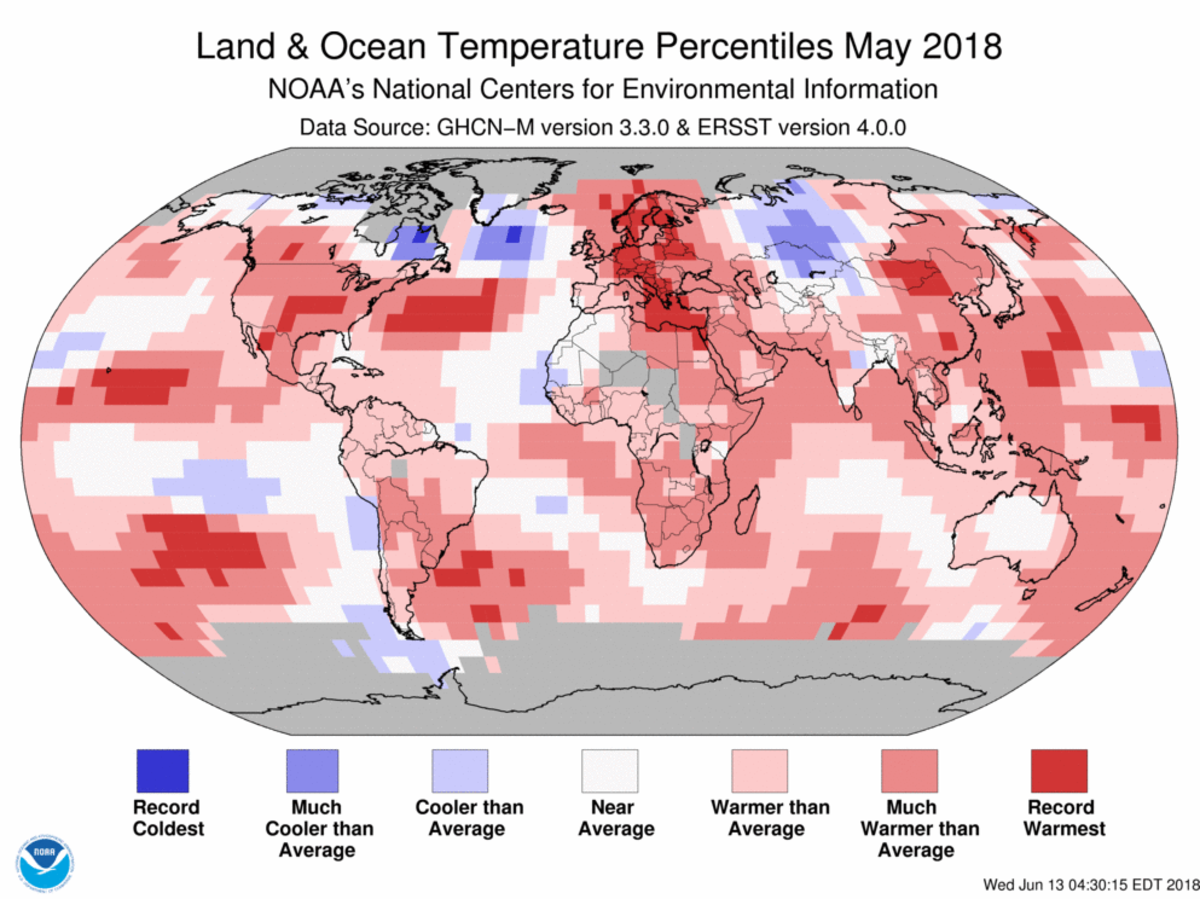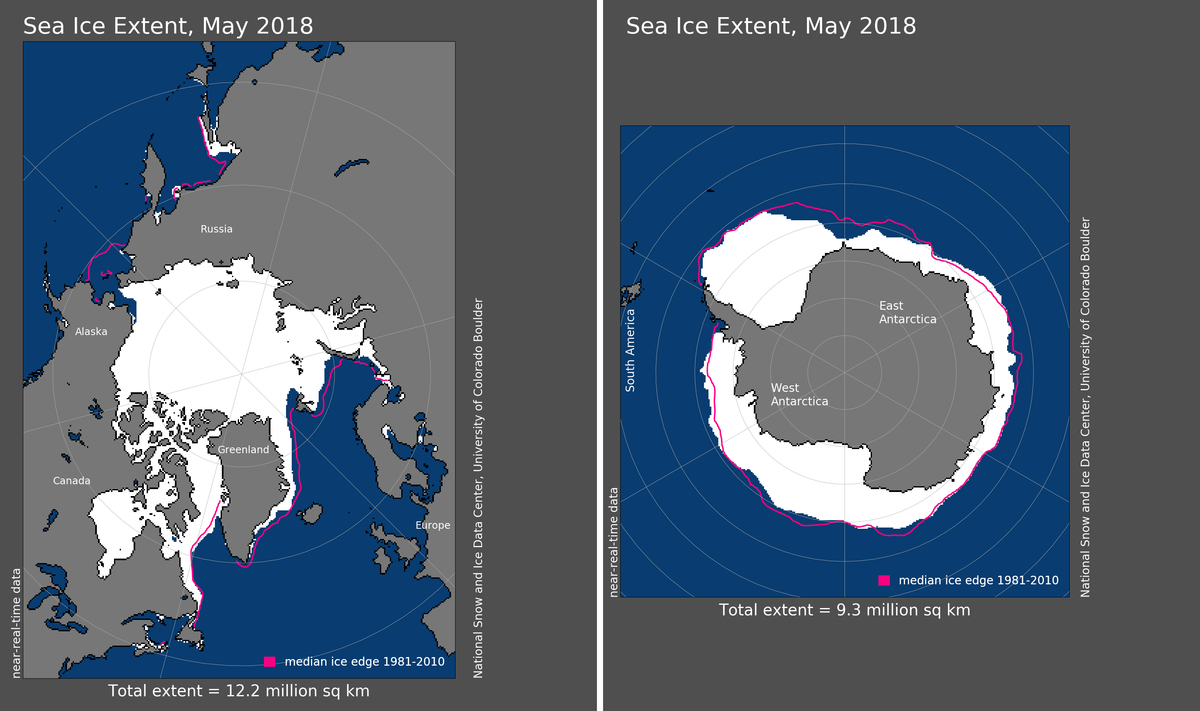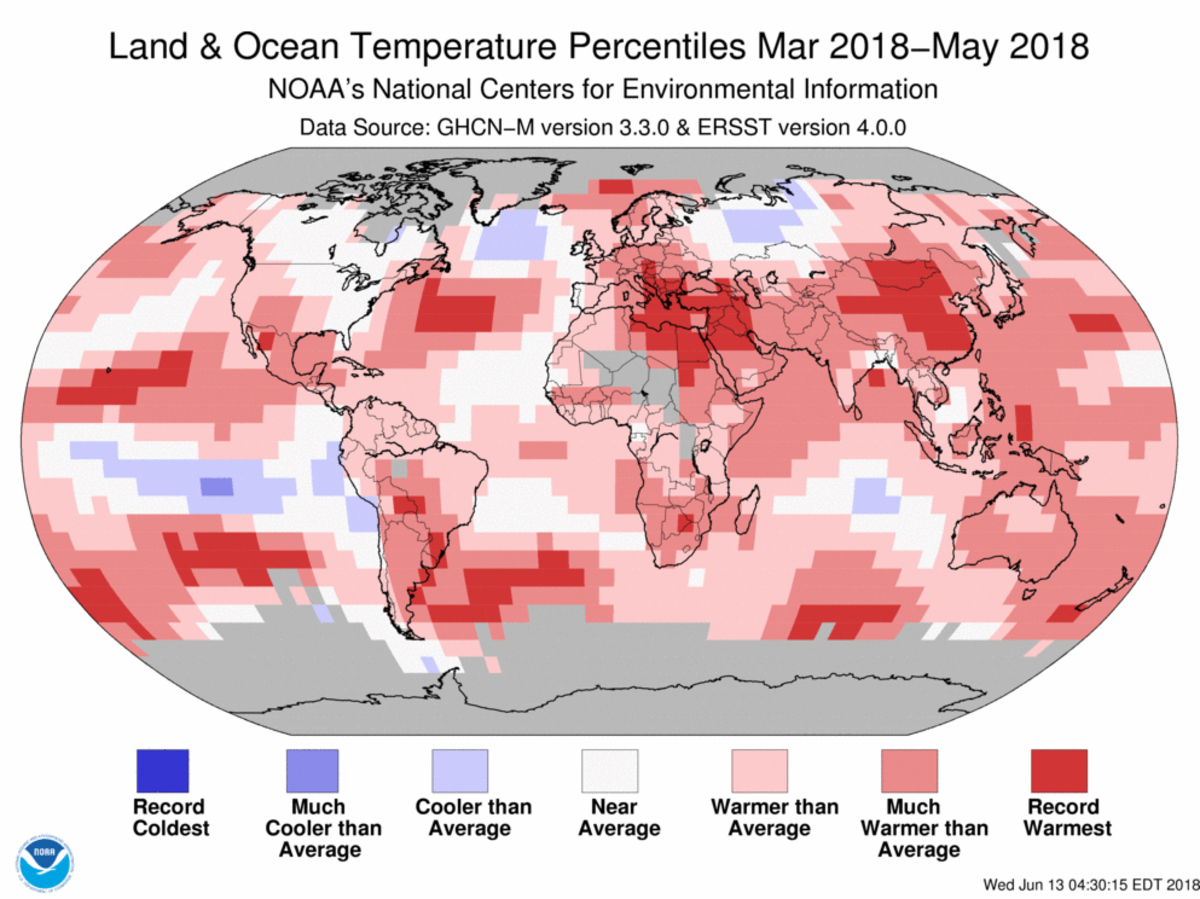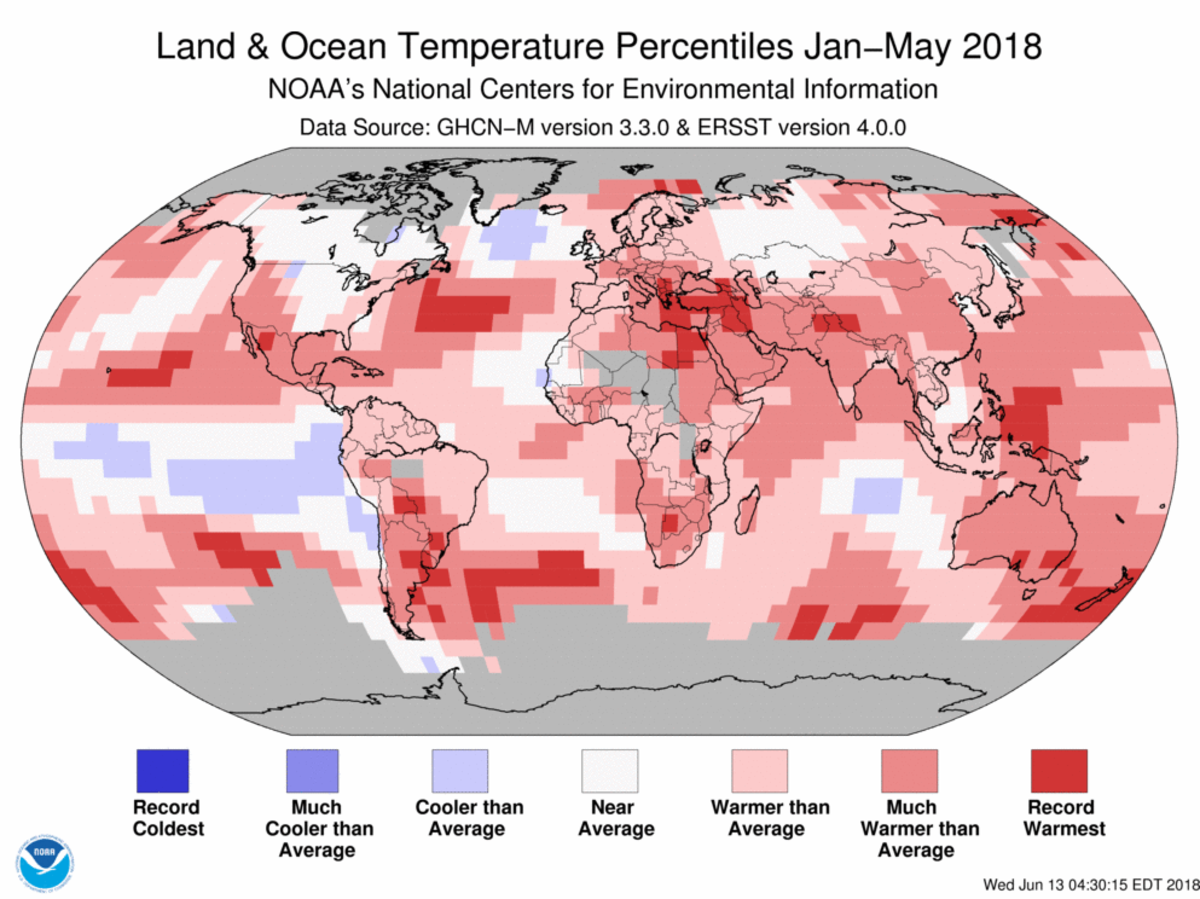
The global land and ocean temperature departure from average for May 2018 was the fourth highest for the month of May in the NOAA global temperature dataset record, which dates back to 1880. The March-May and year-to-date global temperatures were also the fourth warmest such periods on record.
This monthly summary, developed by scientists at NOAA's National Centers for Environmental Information, is part of the suite of climate services NOAA provides to government, business, academia and the public to support informed decision-making.
May 2018 Temperature
The May temperature across global land and ocean surfaces was 1.44°F above the 20th century average of 58.6°F and the fourth highest for May in the 1880-2018 record. The years 2014-2018 rank among the five warmest Mays on record, with 2016 the warmest May at 1.58°F above average. May 2018 also marks the 42nd consecutive May and the 401st consecutive month with temperatures, at least nominally, above the 20th century average.
Record warmth was observed across parts of North America., Europe and Asia as well as the Atlantic, Pacific and Indian Oceans. Record cold May temperatures were limited to northeastern Canada and the northern Atlantic Ocean, off the southern coast of Greenland.
The May globally averaged land surface temperature was 2.05°F above the 20th century average of 52.0°F. This value was the smallest May temperature departure from average since 2011 and tied with 2013 as the seventh highest May land temperature in the 139-year record.
The most notable warm land temperature departures from average during May 2018 were present across much of the contiguous U.S. and Europe, where temperatures were 5.4°F above average or higher. In contrast, the most notable cool land temperature departures from average were present across northeastern Canada and central Russia where temperatures were 5.4°F below average or lower.
Europe had its warmest May since continental records began in 1910 at 4.97°F above average, surpassing the previous record set in 2003 by 1.66°F. May 2018 marked the first time in May that the continental temperature departure from average was 3.6°F (2.0°C) or higher. Several European countries had a record or near-record warm May temperature.
Asia had its smallest May temperature departure from average since 2009.
The May globally averaged sea surface temperature was 1.19°F above the 20th century monthly average of 61.3°F – also the fourth highest global ocean temperature for May in the record. The years 2014-2018 rank among the five warmest Mays on record, with 2016 the warmest May at 1.39°F above average.
May 2018 Sea Ice
The May average Arctic sea ice extent was the second smallest in the 40-year record at 420,000 square miles (8.1 percent) below the 1981-2010 average, according to an analysis by the National Snow and Ice Data Center using data from NOAA and NASA. Only the May Arctic sea ice extent in 2016 was smaller. The near-record low Arctic sea ice extent was mostly due to much-below-average sea ice in the Bering and Chukchi Seas.
Antarctic sea ice extent during May was 330,000 square miles (8.6 percent) below the 1981-2010 average, the third smallest May extent on record. Antarctic sea ice expanded at a rate faster than average during May, with below-average ice coverage continuing for parts of the Weddell Sea.
Seasonal (March-May 2018)
The March-May average temperature across global land and ocean surfaces was 1.48°F above the 20th century average of 56.7°F and the fourth highest for March-May in the 1880-2018 record. This value was 0.45°F cooler than the record high set in 2016 and was the smallest March-May temperature departure from average since 2014.
Record warm temperatures during the three-month period were present across parts of southern Europe, the Middle East, northeastern Africa, China, Mongolia, South America and the Atlantic, Indian and Pacific Oceans. No land or ocean areas had record cold temperatures during March-May 2018.
The globally averaged land surface temperature for March-May was 2.34°F above the 20th century average of 46.4°F. This value was the the fifth highest for March-May in the 139-year record.
Five continents had a March-May 2018 temperature that ranked among the nine warmest such period since continental records began in 1910. Of note, Europe and South America had their third warmest March-May on record.
The March-May globally averaged sea surface temperature was 1.15°F above the 20th century average of 61.0°F – also the fourth highest for March-May in the record.
Year-to-Date (January-May 2018)
The year-to-date temperature across global land and ocean surfaces was 1.39°F above the 20th century average of 55.5°F – tying with 2010 as the fourth highest for January-May in the 139-year record. The 2018 year-to-date value was 0.59°F lower than the record high set in 2016.
The year-to-date globally averaged land surface temperature was 2.18°F above the 20th century average of 42.8°F. This value tied with 2002 as the fifth highest for January-May in the record.
The year-to-date globally averaged sea surface temperature was 1.08°F above the 20th century average of 60.8°F. This was also the fifth highest for January-May in the 1880-2018 record.
For a more complete summary of climate conditions and events, see our May 2018 Global Climate Report.

